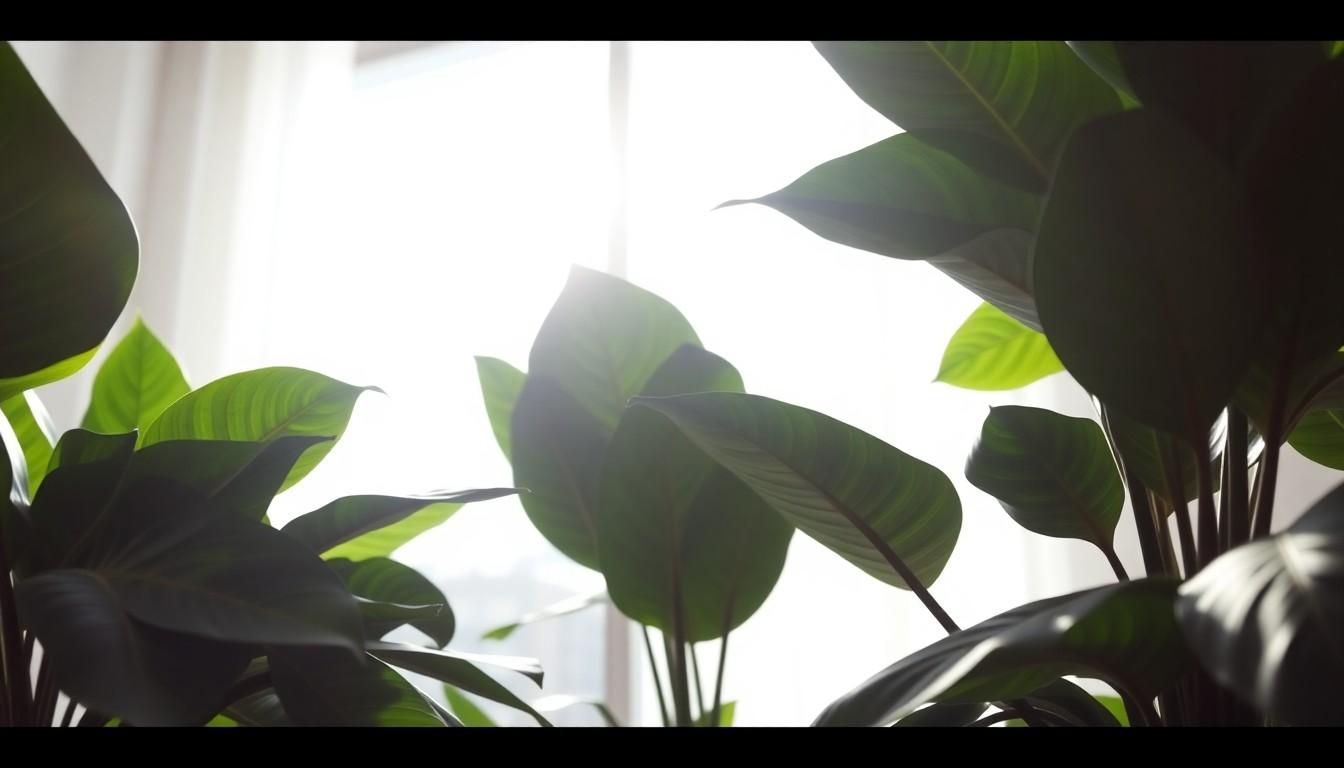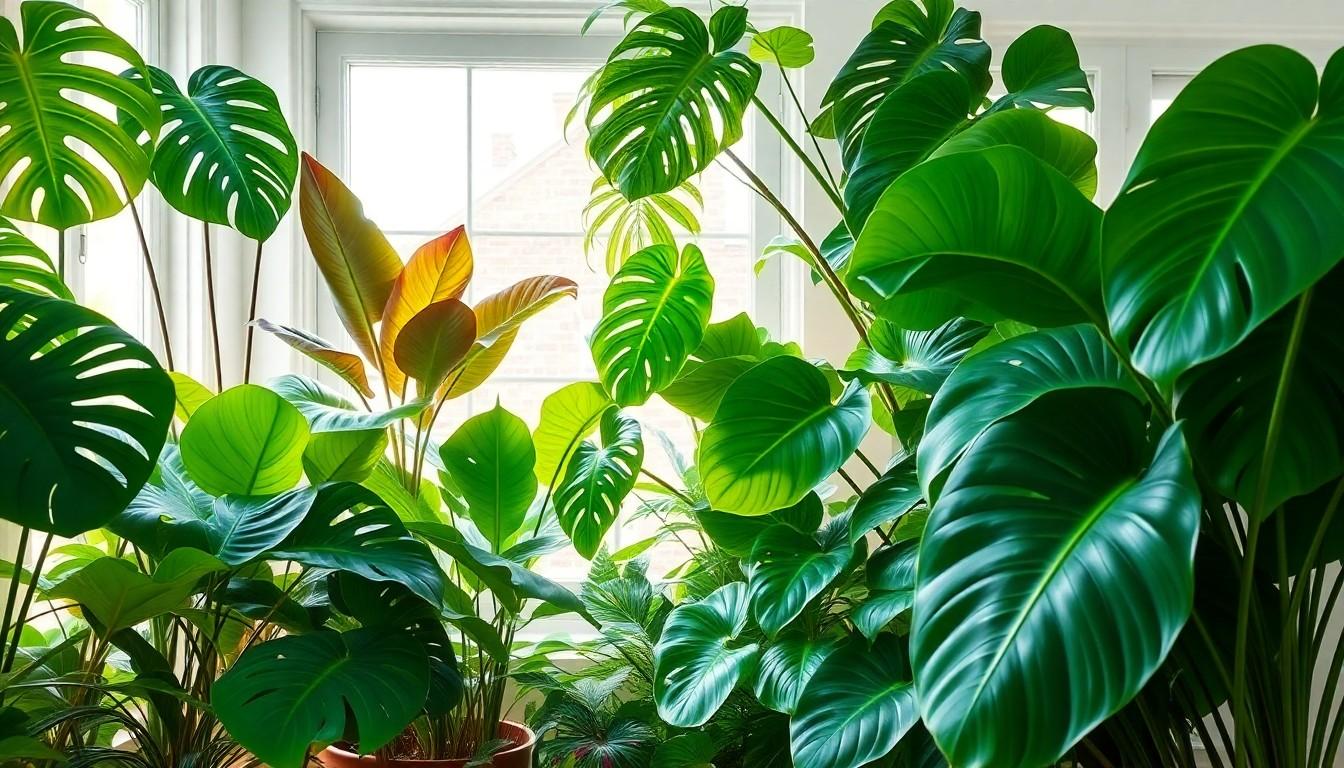Large leaf house plants can turn any living space into a vibrant jungle, but identifying them can feel like a game of botanical hide-and-seek. With their lush foliage and dramatic presence, these green giants not only purify the air but also elevate home decor to new heights. Whether it’s the iconic monstera or the majestic philodendron, knowing how to identify these leafy wonders can make anyone feel like a plant whisperer.
Overview of Large Leaf House Plants
Large leaf house plants attract attention due to their striking appearance and lush foliage. These plants thrive indoors and significantly contribute to an inviting atmosphere. Various species exhibit unique characteristics, making identification essential for plant enthusiasts.
Monstera delicosa, commonly known as the Swiss cheese plant, features dramatic splits and holes in its leaves. This distinctive pattern sets it apart from others. Philodendron bipinnatifidum captivates with its frilly, deeply lobed leaves, adding texture to any interior space.
The alocasia, particularly Alocasia amazonica, boasts arrow-shaped leaves with prominent veins. Its glossy surface creates a stunning focal point. Additionally, the bird of paradise’s large, banana-like leaves bring a tropical feel, enhancing any home’s decor.
Spathiphyllum, known as peace lily, displays broad, dark green leaves accompanied by elegant white blooms. This plant excels at air purification, contributing to healthier living environments. Similarly, the fiddle leaf fig stands out with its oversized, lyre-shaped leaves that command attention and create a statement.
When identifying these plants, one should consider leaf shape, size, and texture. Familiarity with specific features simplifies the process. Observing growth habits and light preferences aids in proper care and maintenance, ensuring longevity.
Understanding large leaf house plants enriches appreciation and connection. Engaging with these natural elements encourages mindfulness and enhances overall well-being. Identifying these varieties opens pathways to explore diverse plant care practices and aesthetic arrangements, furthering the enjoyment of indoor gardening.
Importance of Plant Identification

Identifying large leaf house plants enhances appreciation and care quality. Understanding specific species leads to better indoor gardening experiences.
Benefits of Identifying House Plants
Identifying house plants offers numerous benefits. Knowledge of plant species aids in providing appropriate care. Proper identification leads to tailored watering and light requirements. Recognizing species assists in spotting pests or diseases quickly. Familiarity with plant characteristics strengthens emotional connections with greenery, fostering mindfulness. Enhanced recognition can improve the aesthetic appeal of living spaces.
Common Mistakes in Identification
Common mistakes often occur during plant identification. Confusing similar-looking species can lead to improper care practices. Ignoring subtle differences in leaf shapes may result in mislabeling. Relying solely on visual aspects can overlook growth habits and native conditions. Failing to research a plant’s light and moisture needs may hinder its health. Inaccurate identification can discourage gardeners, affecting their enjoyment of indoor gardening.
Popular Large Leaf House Plants
Large leaf house plants make striking additions to any setting, offering unique shapes and sizes that captivate plant enthusiasts. Here’s a look at some popular options.
Fiddle Leaf Fig
Fiddle leaf figs feature large, lush leaves that stand out prominently in a room. Leaf shapes are broad and fiddle-like, adding drama to the indoor environment. This plant thrives in bright, indirect sunlight and prefers a consistent watering schedule, keeping the soil slightly moist. As it matures, it can reach impressive heights, making it a focal point in living spaces. Choosing the right pot and ensuring proper drainage contributes to its overall health.
Monstera Deliciosa
Monstera deliciosa is beloved for its distinct, split leaves, which create a tropical feel indoors. Growth can be rapid under optimal conditions, with leaves developing unique holes as they mature. Preferring bright, indirect light, this plant requires periodic watering to maintain soil moisture. The soil should drain well to prevent overwatering, which can lead to root rot. Monstera not only adds aesthetic value but also enhances air quality, making it a rewarding choice for plant lovers.
Rubber Plant
Rubber plants boast large, glossy leaves that add elegance to any indoor space. These leaves can vary in color, from deep green to variegated patterns, bringing visual interest. They adapt well to various light conditions, with a preference for bright, indirect sunlight. Watering should be done when the top inch of soil feels dry, promoting healthy growth while avoiding over-saturation. With proper care, rubber plants can grow several feet tall, making them a stunning centerpiece in home decor.
Identification Techniques
Identifying large leaf house plants involves careful observation and the use of specific tools. By honing identification skills, one enhances the indoor gardening experience.
Visual Characteristics to Observe
Pay attention to the leaf shape, size, and texture of the plants. Monstera deliciosa features large, split leaves, while philodendron bipinnatifidum showcases deeply lobed foliage. Observe color patterns as well; variegated leaves can indicate specific varieties. Additionally, leaf surface texture provides clues; glossy leaves of rubber plants differ from the matte finish of peace lilies. Growth habit also aids identification; some plants grow upright, while others may trail or spread out. Understanding these visual characteristics fosters a deeper connection with house plants.
Tools for Identification
Use apps designed for plant identification to streamline the process. These applications allow users to upload images for instant recognition. Field guides offer another resource, providing detailed descriptions and photos of various species. A simple magnifying glass enhances close examination, revealing fine details on leaves. Labels and tags can help track plant specifics, ensuring accurate identification over time. Each of these tools supports the goal of proper plant care and enrichment of indoor gardening.
Conclusion
Identifying large leaf house plants opens up a world of possibilities for indoor gardening enthusiasts. By understanding the unique characteristics of each plant, gardeners can provide tailored care that promotes health and vibrancy. This knowledge not only enhances the aesthetic appeal of living spaces but also fosters a deeper emotional connection with nature.
As they engage with their plants, individuals can cultivate mindfulness and improve their overall well-being. Embracing the art of plant identification transforms indoor gardening into a rewarding experience that enriches both the home and the heart. With the right tools and techniques, anyone can become adept at recognizing these stunning green companions.

